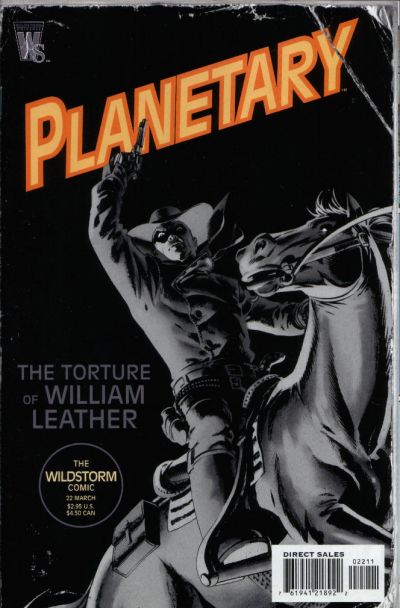I was a bit unsure about whether or not I would enjoy this miniseries (originally published in Streets of Glory # 1-6, from October 2007 to October 2008), but I’ve always trusted in Ennis’ talent and I haven’t been disappointed so far. While Reading Streets of Glory I thought about my relationship with the western as a genre. Although at a first glance one would only think of gunslingers, Indians and horses, the truth is that there is much that can be told in the pages of a western. Against all odds, even I decided to write a 2-page story for a western-themed anthology, a few years ago, and while I was writing it I realized that there is much that can be done within the genre.
The idea of seeing the United States as a primitive nation, still in formation, can be quite fascinating. And I believe that’s why Ennis decided to set the story in 1899, and why he chose Joseph Dunn as the protagonist. In 2 years the 19th century will come to an end, and men like Dunn, who used to solve every problem with a bullet are about to face extinction.
The narrator of the story is Peter Lorrimer, a teenager who witnesses the murder of his brother and whose life is saved by colonel Joseph Dunn. As the story progresses, both characters try to settle in Gladback, a small town that is also the target of speculator and wealthy business man, Mr. Morrison. However, what begins as the classic clash between civilization and barbarism, represented by the need for a new railroad and the threat of Red Crow, a savage Indian who brutally kills white men, turns into something more complex.
Dunn will go after Red Crow, there will be a fierce battle in which many men are massacred, but in the end Dunn manages to kill the Indian. Nevertheless, that isn’t the end of the story. Because Dunn starts wondering why Red Crow was there in the first place, and what role Mr. Morrison is playing. Men like Dunn have exterminated the Indians and now is the turn for men like Morrison to build a new nation. The bravest man in the whole wild west has but one big fear: “I’m scared I fought hard for the country. Only to hand it to fools”.
 |
| Peter's brother dies / el hermano de Peter muere |
In Ennis’ own words: “I wanted to write a story that would feature the horror and brutality of the West without flinching, while at the same time not simply drowning the narrative in squalor and gore. There’s an epic quality to the great Westerns that I didn’t want to lose; the incredible scale of the country, the sense of myth that the people and places contributed to. ‘There was good in amongst all the bad’ is a simple way of putting it- probably overly so”.
Artist Mike Wolfer was certainly the right choice for this project. There are many extremely violent scenes throughout the miniseries and Wolfer really stands out at showing us all the blood and the viscera. He’s also in charge of all the regular and variant covers, some of which are a real delight. This is a really good Avatar miniseries that all Western fans will surely enjoy.
________________________________________________________________________________________________
________________________________________________________________________________________________
Streets of Glory es un western empapado de sangre pero también de lágrimas nostálgicas. El escritor irlandés Garth Ennis tiene una habilidad increíble para reconstruir el pasado estadounidense, más específicamente los últimos años del siglo XIX, mientras que al mismo tiempo reflexiona sobre cuestiones políticas y analiza qué significaba realmente eliminar a los indios y construir ferrocarriles en el salvaje oeste.
 |
| Red Crow |
La idea de ver a los Estados Unidos como una nación primitiva, todavía en formación, puede ser bastante fascinante. Y creo que es por eso que Ennis decidió establecer la historia en 1899, y por eso eligió a Joseph Dunn como protagonista. En 2 años el siglo XIX llegará a su fin, y hombres como Dunn, que solían resolver cada problema con una bala, están a punto de enfrentar la extinción.
 |
| Joseph Dunn & Peter |
Dunn perseguirá a Red Crow, habrá una feroz batalla en la que muchos hombres serán masacrados, pero al final Dunn logra matar al indio. Sin embargo, ese no es el final de la historia. Porque Dunn comienza a preguntarse por qué Red Crow estuvo allí en primer lugar, y qué papel juega el Sr. Morrison. Hombres como Dunn han exterminado a los indios y ahora les toca a hombres como Morrison construir una nueva nación. El hombre más valiente de todo el salvaje oeste tiene un gran temor: “Tengo miedo de haber luchado duro por el país. Sólo para dárselo a los tontos”.
 |
| Dunn's past / el pasado de Dunn |
En las propias palabras de Ennis: “Quería escribir una historia que presentara el horror y la brutalidad del oeste sin titubear, mientras que al mismo tiempo la narración no se ahogara en la miseria y la sangre derramada. Hay una cualidad épica para los grandes westerns que no quería perder; la increíble escala del país, el sentido del mito al que contribuyeron las personas y los lugares. ‘Hubo algo bueno entre todo lo malo’ es una manera simple de decirlo, probablemente hasta la exageración”.
El artista Mike Wolfer fue ciertamente la elección correcta para este proyecto. Hay muchas escenas extremadamente violentas en toda la miniserie y Wolfer realmente se destaca al mostrarnos toda la sangre y las vísceras. También está a cargo de todas las portadas regulares y variantes, y algunas son una verdadera delicia. Esta es una miniserie de Avatar realmente buena que todos los fanáticos del western seguramente disfrutarán.








